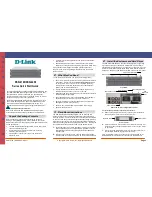
IDT Clocking, Reset, and Initialization
Clock Operation
PES16NT2 User Manual
2 - 5
April 15, 2008
Notes
Reset
PCI Express® defines two reset categories: fundamental reset and hot reset. A fundamental reset
causes all associated logic to be returned to an initial state. A hot reset causes all associated logic to be
returned to an initial state, but does not cause the state of register fields denoted as “sticky” to be modified.
There are two sub-categories of fundamental reset: cold reset and warm reset. A cold reset occurs
following a device being powered on and assertion of PERSTN. A warm reset is a fundamental reset that
occurs without removal of power.
A summary of reset conditions and their effect is exhibited in Table 2.4.
PERSTN
I
Fundamental Reset.
Assertion of this signal resets all logic inside the
PES16NT2 and initiates a PCI Express fundamental reset.
RSTHALT
I
Reset Halt.
When this signal is asserted during a PCI Express fundamental
reset, the PES16NT2 executes the reset procedure and remains in a reset
state with the Master and Slave SMBuses active. This allows software to
read and write registers internal to the device before normal device opera-
tion begins. The device exits the reset state when the RSTHALT bit is
cleared in the PA_SWCTL register by an SMBus master.
SWMODE[3:0]
I
Switch Mode.
These configuration pins determine the PES16NT2 switch
operating mode.
0x0 - Transparent mode
0x1 - Transparent mode with serial EEPROM initialization
0x2 - Non-transparent mode
0x3 - Non-transparent mode with serial EEPROM initialization
0x4 - Non-transparent failover mode
0x5 - Non-transparent failover mode with serial EEPROM initialization
0x6 through 0xF - Reserved
Fund.
Reset
Global
Hot
Reset to
Entire
Device
Global
Hot
Reset to
Downstr
eam
Ports
Local
Hot
Reset
Ext.
NTB
Fund.
Reset
1
Ext.
NTB
Hot
Reset
Master SMBus
Y
N
N
N
N
N
Slave SMBus
Y
N
N
N
N
N
Serial EEPROM Initial-
ization
Y
if mode
requires it
N
N
N
N
N
Switch Core
Y
Y
N (flush
buffer
only)
N
N
N
Port A All Registers
Y
N
N
N
N
N
Port A All Registers
Except Those of Type
Sticky or RWL
Y
Y
N
N
N
N
Table 2.4 Reset Conditions and Their Effect (Part 1 of 2)
Signal
Type
Name/Description
Table 2.3 System Pins (Part 2 of 2)
Содержание 89HPES16NT2
Страница 14: ...DT List of Figures PES16NT2 User Manual viii April 15 2008 Notes...
Страница 20: ...IDT Register List PES16NT2 User Manual xiv April 15 2008 Notes...
Страница 32: ...IDT PES16NT2 Device Overview PES16NT2 User Manual 1 12 April 15 2008 Notes...
Страница 44: ...IDT Clocking Reset and Initialization Clock Operation PES16NT2 User Manual 2 12 April 15 2008 Notes...
Страница 50: ...IDT Link Operation PES16NT2 User Manual 3 6 April 15 2008 Notes...
Страница 62: ...IDT Power Management PES16NT2 User Manual 5 4 April 15 2008 Notes...
Страница 78: ...IDT SMBus Interfaces PES16NT2 User Manual 6 16 April 15 2008 Notes...
Страница 83: ...IDT NTB Upstream Port Failover PES16NT2 User Manual 7 5 April 15 2008 Notes...
Страница 84: ...IDT NTB Upstream Port Failover PES16NT2 User Manual 7 6 April 15 2008 Notes...
Страница 130: ...IDT Transparent Mode Operation PES16NT2 User Manual 9 44 April 15 2008 Notes...
Страница 284: ...IDT Non Transparent Mode Operation PES16NT2 User Manual 10 154 April 15 2008 Notes...
















































